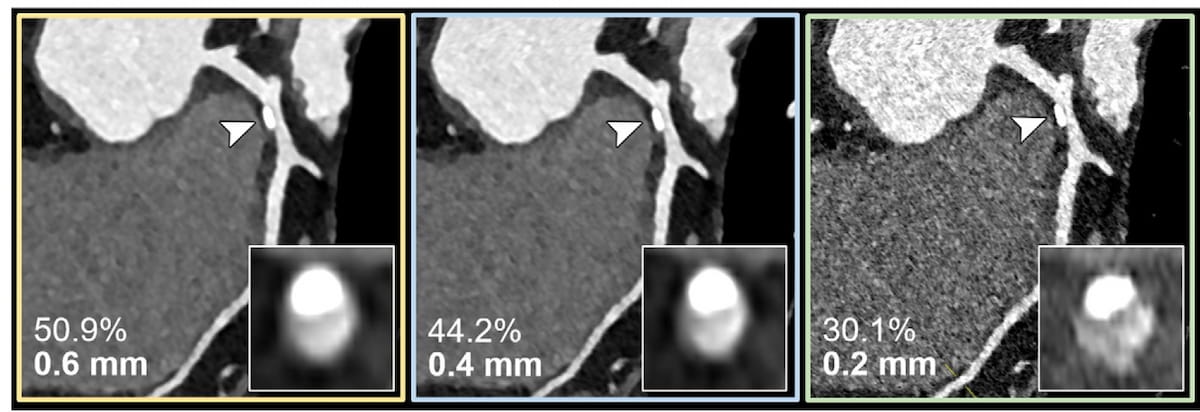New research demonstrates that photon-counting computed tomography (PCCT) with ultrahigh spatial resolution significantly alters stenosis assessments in patients with known or suspected coronary artery disease (CAD).
For the study, recently published in Radiology, researchers compared standard computed tomography (CT) resolution (SR) with high spatial resolution (HR) and ultrahigh spatial resolution (UHR) with PCCT in an in vitro analysis involving 25 percent and 50 percent stenoses. The study authors also assessed the impact of the different resolutions in a retrospective in vivo analysis of 114 patients (mean age of 68) with known or suspected CAD.
Ultrahigh spatial resolution (UHR) with PCCT revealed lower diameter stenosis (DS) percentage for 25 percent and 50 percent stenoses than HR and SR, according to the study authors. For 50 percent stenosis, UHR had a 51.9 percent DS in contrast to 58.3 percent DS for HR and 60 percent DS for SR. For 25 percent stenosis, the in vitro analysis showed a 27.3 percent DS for UHR in comparison to 32.4 percent for HR and 34.2 percent for SR.
Overall results from the in vivo analysis also showed a lower DS percentage per stenosis for UHR (29.2 percent) versus 36.7 percent for HR and 41.5 percent for SR.
“With a reduction of the mean bias to 2.3 percent, our study confirms previous findings that ultrahigh resolution-based percentage DS measurements are comparable to the actual degree of stenosis,” wrote Moritz C. Halfmann, M.D., who is affiliated with the Department of Diagnostic and Interventional Radiology at the University Medical Center of the Johannes Gutenberg University Mainz in Mainz, Germany, and colleagues.
The study authors also found that 54.4 percent of the cohort was assigned lower Coronary Artery Disease Reporting and Data System (CAD-RADS) categories due to the use of UHR reconstructions with PCCT.
Three Key Takeaways
1. Ultrahigh Spatial Resolution (UHR) with photon-counting computed tomography (PCCT) enhances the accuracy of stenosis measurements. Photon-counting computed tomography with UHR significantly changes stenosis assessments in patients with known or suspected coronary artery disease (CAD). The study reveals that UHR with PCCT yields lower diameter stenosis (DS) percentages for both 25 percent and 50 percent stenoses compared to traditional high spatial resolution (HR) and standard resolution (SR) methods.
2. Clinical reclassification rates. The use of UHR reconstructions with PCCT led to clinically relevant reclassification rates in the study cohort. Approximately 54.4 percent of patients were assigned lower Coronary Artery Disease Reporting and Data System (CAD-RADS) categories with UHR. Notably, assessments in CAD-RADS category 1 (plaque without stenosis) were significantly higher with UHR compared to HR and SR, potentially impacting downstream tests and suggesting that a substantial portion of recommended tests could have been avoided.
3. Quantification of stenosis severity. A key strength of the study lies in the quantification of diameter stenosis (DS) percentage. In contrast to prior subjective assessments, the use of software tools in the study allowed for more precise measurements of stenosis severity.
Specifically, the researchers noted that CADS-RADS category 1 (plaque without stenosis) assessments were nearly 25 percent higher with UHR (40.4 percent) in comparison to SR (15.7 percent) and more than 15 percent higher than HR (24.6 percent). The study authors pointed out that CADS-RADS category 4 assignments (severe stenosis) with SR (18 patients, 15.7 percent) were reduced by half with the use of UHR (9 patients, 7.9 percent).
“Our study suggests clinically relevant reclassification rates. Considering the treatment recommendations for patients with stable chest pain, close to half of the recommended downstream tests (e.g. functional evaluation and invasive coronary angiography) could have been avoided,” emphasized Halfmann and colleagues.
(Editor’s note: For related content, see “Emerging Concepts with ICM Reduction and Photon Counting for Coronary CT Angiography,” “Study Examines Photon-Counting CT for CAD Detection in Patients Having TAVR Procedures” and “Study Offers Closer Look at Patient Preference for CT Angiography Over Invasive Coronary Angiography.”)
In an accompanying editorial, Cynthia H. McCollough, Ph.D., said a key strength of the study is the quantification of DS percentage, a marked contrast to prior subjective assessments of stenosis severity.
“The software tools segment the arterial lumen from the background material or anatomy, including adjacent calcifications, and compare the diameter of the vessel at the point of the stenosis to the estimated diameter of the lumen at the same location along the vessel,” noted Dr. McCollough, the Brooks-Hollern Professor at the Mayo Clinic in Rochester, Minn. “This latter parameter is estimated using a linear interpolation between the lumen diameters proximal and distal to the position of the stenosis.”
In regard to study limitations, the researchers acknowledged the majority of patients didn’t have a clinical indication for invasive coronary angiography so there was no physical reference for in vivo measurements. The study authors pointed out there was minimal assessments of mixed or non-calcified plaques as calcified plaques caused the majority of coronary stenoses in the study. Reconstructed images with standard resolution were simulations of images drawn from conventional energy-integrating detector CT, according to the researchers.
